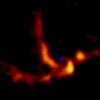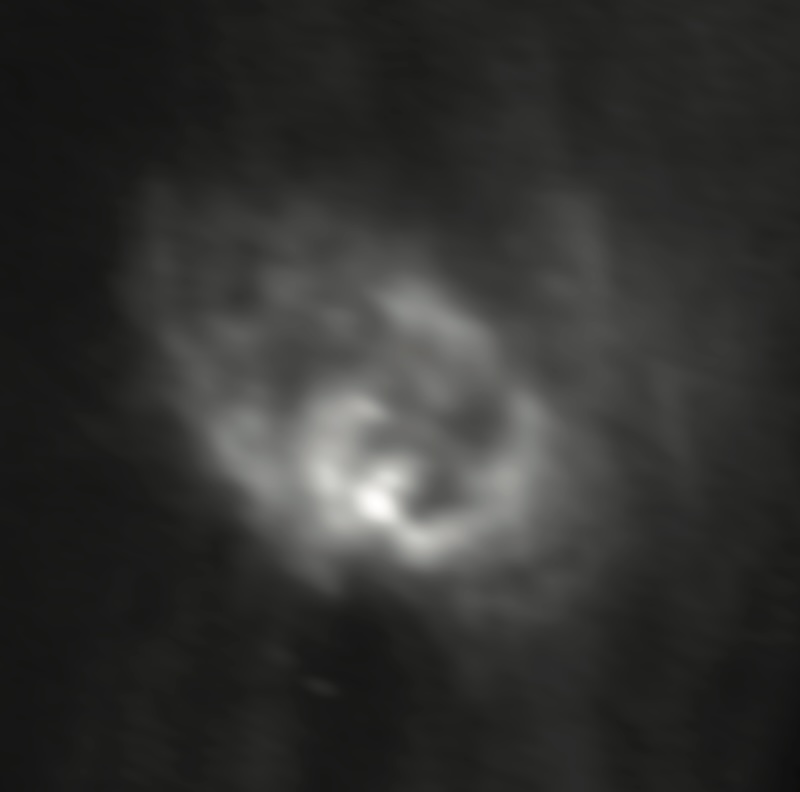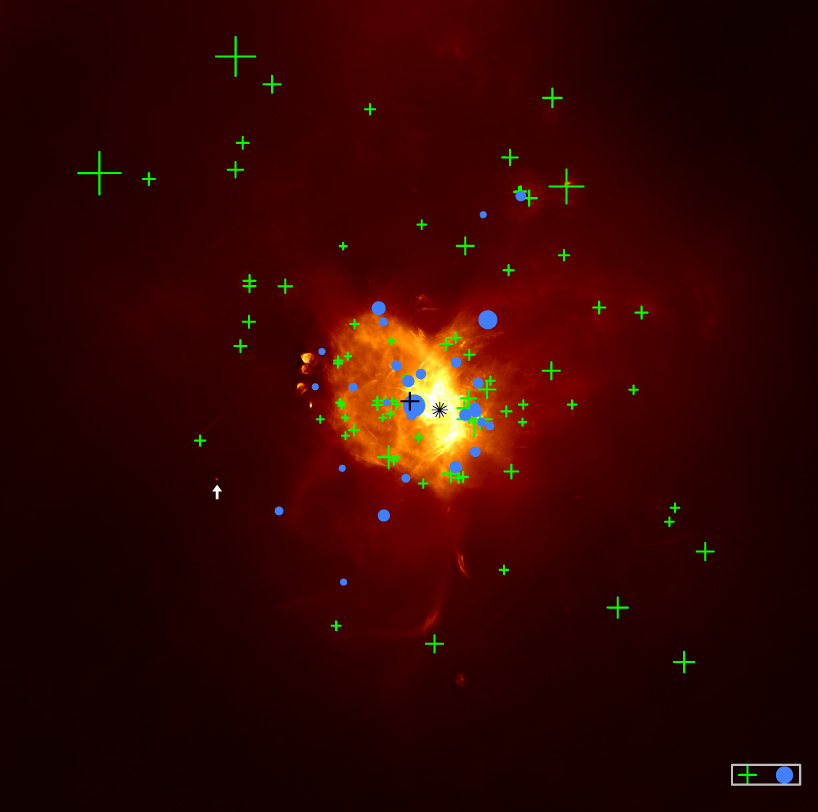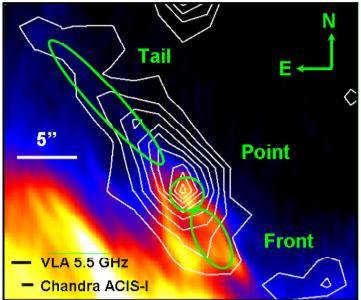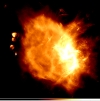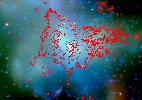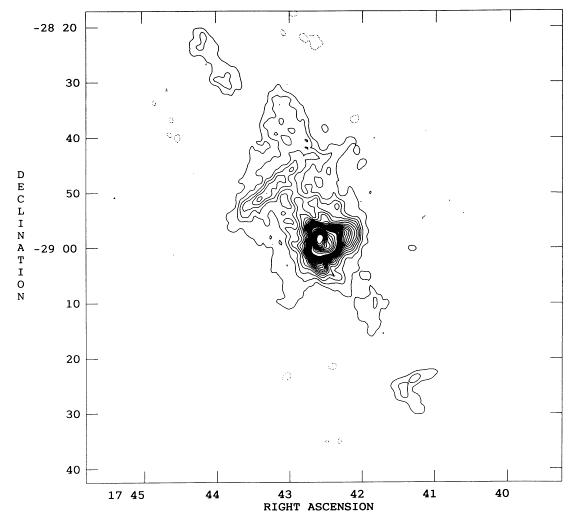| Sgr A: Feedback from Nuclear Activity | ||||||||||||||||||||||||||||
|
Abstract We investigate the nature of a Galactic Centre source, G0.17+0.15, lying along the northern extension of the radio arc near l∼0.2◦. G0.17+0.15 is an H II region located towards the eastern edge of the radio bubble, embedded within the highly polarized Galactic Centre eastern lobe where a number of radio filaments appear to cross through the H II region. We report the detection of hydrogen and helium recombination lines with a radial velocity exceeding 140 km s−1 based on Green Bank Telescope and Very Large Array observations. The morphology of G0.17+0.15, aided by kinematics, and spectral index characteristics, suggests the presence of an external pressure dragging and shredding the ionized gas. We argue that this ionized cloud is interacting with a bundle of radio filaments and is entrained by the ram pressure of the radio bubble, which itself is thought to be produced by cosmic ray driven outflows at the Galactic Centre. In this interpretation, the gas streamers on the western side of G0.17+0.15 are stripped, accelerated from 0 to δv∼ 35 km s−1 over a time-scale roughly 8 × 104 yr, implying that ablating ram pressure is∼ 700 eV cm−3, comparable to the∼ 103 eV cm−3 cosmic ray driven wind pressure in the Galactic Centre region.
Abstract A population of 1000 compact radio sources is newly detected with the VLA, in the flux-density range between a few tens of Jy and a few mJy at 5.5 GHz, within the radio bright zone (15 arcmin or 35 parsecs) at the Galactic center. With high-resolution VLA observations at multiple epochs, among the thousand compact radio sources detected, we have identified about 80 transients and variables that are distributed along the Galactic plane in the nuclear region. These radio variables likely arise from unstable accretion processes in binary systems associated with stellar black holes and neutron stars. We report our preliminary findings by showing the spatial and flux-density distributions of the radio variables based on the existing 5.5-GHz VLA data observed during 2012 and 2019. Meanwhile, we are proposing a follow-up VLA study of their radio properties in terms of spectral index, intra-day variability and linear polarization as well as a cross-correlation analysis between radio and X-ray. Some of the compact radio sources show remarkable proper motions; for example, the radio counterpart of the X-ray Cannonball shows a significant proper motion as well as the presence of pulsar wind nebula emission, consistent with our earlier hypothesis that the compact radio source is likely associated with a runaway neutron star created in the event that produced the Sgr A East supernova remnant. The sensitive VLA wide-band observations at relatively high resolution may provide important clues for elucidating the problem of the missing populations of millisecond pulsars and ordinary pulsars at the Galactic center.
Abstract Using Jansky Very Large Array data obtained from high-resolution observations at 5.5 GHz at multiple epochs in 2014 and 2019, we have detected a population of radio variables and transients in the radio-bright zone at the Galactic center. With observations covering a sky area of 180 arcmin2 at an angular resolution of 0farcs4, we report new detections of 110 Galactic center compact radio (GCCR) sources with a size of <1''. The flux densities of GCCR sources exceed 70 μJy, with at least 10σ significance. Among these sources, 82 are variable or transient and 28 are nonvariable. About 10% of them are expected to be extragalactic background sources. We discuss the possible astrophysical nature of the detected sources. As compared to the Galactic disk (GD) population of normal pulsars (NPs) and millisecond pulsars (MSPs), a majority (80%) of the GCCR sources appear to fall within the high flux density tail of the pulsar distribution, as extrapolated from a sample of NPs in the GD. However, MSPs extrapolated from the GD population are too weak to have contributed significantly to the GCCR population that has been detected. We also cross-correlated the GCCR sources with X-ray sources in Chandra X-ray catalogs and found that 42 GCCR sources have candidate X-ray counterparts. Most of the GCCR sources having X-ray counterparts are likely to be associated with unresolved or slightly resolved radio jets launched from X-ray binaries with a compact object, either a black hole or a neutron star.
Abstract
New observations of Sgr A have been carried out with the Jansky VLA in
the B and C arrays using the broadband (2 GHz) continuum mode at 5.5 GHz.
The field of view covers the central 13' (30 pc) region of the
radio-bright zone at the Galactic center. Using the multi-scale and
multi-frequency-synthesis (MS-MFS) algorithms in CASA, we have imaged
Sgr A with a resolution of 1", achieving an rms noise of 8 $\mu$Jy/beam,
and a dynamic range of 100,000:1. Both previously known and newly identified
radio features in this region are revealed, including numerous filamentary
sources. The radio continuum image is compared with Chandra X-ray images,
with a CN emission-line image obtained with the SMA and with detailed
Paschen-$\alpha$ images obtained with HST/NICMOS. We discuss several
prominent features in the radio image. The "Sgr A West Wings" extend 2" (5 pc)
from the NW and SE tips of the Sgr A West HII region (the "Mini-spiral")
to positions located 2.9 and 2.4 arc min to the northwest and
southeast of Sgr A*, respectively. The NW wing, along with several
other prominent features, including the previously identified "NW Streamers",
form an elongated radio lobe (NW lobe), oriented nearly perpendicular
to the Galactic plane. This radio lobe, with a size of
6.3' x 3.2' (14.4 pc x 7.3 pc), has a known X-ray counterpart.
In the outer region of the NW lobe, a row of three thermally emitting
rings is observed. A field containing numerous amorphous radio
blobs extends for a distance of ~2 arc min beyond the tip of the SE wing;
these newly recognized features coincide with the SE X-ray lobe.
Most of the amorphous radio blobs in the NW and SE lobes have
Paschen-$\alpha$ counterparts. We propose that they have been produced
by shock interaction of ambient gas concentrations with a collimated
nuclear wind or an outflow that originated from within the circumnuclear
disk (CND). We also discuss the possibility that the ionized wind or outflow has
been launched by radiation force produced by the central star cluster.
Finally, we remark on the detailed structure of a prominent radio emission
feature located within the shell of the Sgr A East supernova remnant. Because
this feature -- the "Sigma Front" -- correlates well in shape and orientation with
the nearby edge of the CND, we propose that it is a reflected shock wave
resulting from the impact of the Sgr A East blast wave on the CND.
Abstract We present the first high-energy X-ray (>10 keV) observations of the non-thermal filament G359.97-0.038 using the Nuclear Spectroscopic Telescope Array (NuSTAR). This filament is one of approximately 20 X-ray filaments of unknown origin located in the central 20 pc region in the Galactic Center near Sgr A*. Its NuSTAR and Chandra broadband spectrum is characterized by a single power law with Γ = 1.3 ± 0.3 that extends from 2 to 50 keV, with an unabsorbed luminosity of 1.3 x 1033 erg s-1 (d/8 kpc)2 in the 2-8 keV band. Despite possessing a cometary X-ray morphology that is typical of a pulsar wind nebula (PWN) in high-resolution Chandra imaging, our spatially resolved Chandra spectral analysis found no significant spectral softening along the filament as would be expected from particle synchrotron cooling. Coincident radio emission is detected using the Very Large Array at 5.5 and 8.3 GHz. We examine and subsequently discard a PWN or magnetic flux tube as the origin of G359.97-0.038. We use broadband spectral characteristics and a morphological analysis to show that G359.97-0.038 is likely an interaction site between the shell of Sgr A East and an adjacent molecular cloud. This is supported by CS molecular line spectroscopy and the presence of an OH maser.
Abstract We report the VLA detection of the radio counterpart of the X-ray object referred to as the "Cannonball", which has been proposed to be the remnant neutron star resulting from the creation of the Galactic Center supernova remnant, Sagittarius A East. The radio object was detected both in our new VLA image from observations in 2012 at 5.5 GHz and in archival VLA images from observations in 1987 at 4.75 GHz and in the period from 1990 to 2002 at 8.31 GHz. The radio morphology of this object is characterized as a compact, partially resolved point source located at the northern tip of a radio "tongue" similar to the X-ray structure observed by Chandra. Behind the Cannonball, a radio counterpart to the X-ray plume is observed. This object consists of a broad radio plume with a size of 30"x15", followed by a linear tail having a length of 30". The compact head and broad plume sources appear to have relatively flat spectra (~\nu\alpha) with mean values of \alpha=-0.44\pm0.08 and -0.10\pm0.02, respectively; and the linear tail shows a steep spectrum with the mean value of -1.94\pm0.05. The total radio luminosity integrated from these components is {$\sim8\times10^{33}$ erg s-1, while the emission from the head and tongue amounts for only ~1.5x1031 erg s-1. Based on the images obtained from the two epochs' observations at 5 GHz, we infer the proper motion of the object: \mu\alpha = 0.001\pm0.003 arcsec yr-1 and \mu\delta = 0.013\pm0.003 arcsec yr-1. With an implied velocity of 500 km s-1, a plausible model can be constructed in which a runaway neutron star surrounded by a pulsar wind nebula was created in the event that produced Sgr A East. The inferred age of this object, assuming that its origin coincides with the center of Sgr A East, is approximately 9000 years.
Abstract The first deep imaging of the Sgr A complex at the Galactic Center at 6 cm wavelength with the B and C configurations of the Karl G. Jansky Very Large Array has achieved unprecedented sensitivity, and has consequently revealed a new population of faint filamentary features, that, like their brighter counterparts seen throughout the Galactic Center on larger scales, can extend up to ~10 parsecs, and in most cases are strikingly uniform in their brightness and curvature. The spectral index map derived from these broad-band observations supports the nonthermal nature of these structures. Previously known nonthermal filaments (NTFs) are seen in the new image to have considerable filamentary substructure. Two well-known radio sources to the south of Sgr A - sources E and F - consist of numerous quasi-parallel filaments that can now be seen as particularly bright portions of a much larger, strongly curved, continuous, nonthermal radio structure that we refer to as the "southern curl". It is therefore unlikely that sources E and F are HII regions or pulsar wind nebulae. The southern curl has a smaller counterpart on the opposite side of the Galactic Center - the northern curl - that, except for its smaller scale and smaller distance from the center, is remarkably point-reflection symmetric with respect to the southern curl. Adopting the current paradigm for the NTFs - that they illuminate local magnetic field lines - we find that the magnetic field in the vicinity of the Sgr A complex does not show the same largescale trend of being roughly perpendicular to the Galactic plane that has previously been noted for NTFs on larger scales. Furthermore, the curl features indicate that some field lines are presently being strongly distorted, presumably by mass flows. The point symmetry about the center then suggests that the flows originate near the center and are somewhat collimated. Finally, by comparison with earlier 6cm VLA observations, we find that the intensity of the NTFs is time-variable.
Abstract We have observed Sgr A with the Jansky VLA in the B and C arrays using the broadband (2 GHz) continuum mode at 5.5 GHz covering the central 13'(30 pc) region of the radio bright zone at the Galactic Center. With the CASA multi-scale and multifrequency-synthesis (MS-MFS) clean algorithm, we constructed a deep image, achieving an rms noise level of 0.01 mJy/beam, or a dynamic range 80,000:1. Our observations have revealed the detailed structures of both previously known and newly identified radio sources in this region. Numerous compact radio sources have been detected at a level of ~0.1 mJy/beam. Among them, we have identified the radio counterpart of the X-ray object referred to as the Cannonball, and have imaged its radio structure, yielding its quantitative radio characteristics and proper motion. Our VLA observations are consistent with the plausible model proposed by Park et al. (2005), in which a runaway neutron star surrounded by a pulsar wind nebula was created in the event that produced Sgr A East ~9,000 yrs ago. The deep radio image has been compared with the Chandra X-ray and HST/NICMOS Paschen-alpha images. In the radio, broad "Wing" extend 100" (4 pc) from the tips of the mini spiral (the Sgr A West HII region) to the NW and SE; the NW Wing, along with several radio emission "Trunks", forms an elongated radio lobe with a size of 6'x3'(14x7 pc), and is oriented perpendicular to the Galactic plane, in projection. In the outer region of the NW lobe, a row of three emission rings is present. The NW radio lobe matches well with its X-ray counterpart (Morris et al. 2002). An amorphous radio emission structure at the tip of the SE Wing and an emission trunk (120"x20", or 4.6 x 0.8 pc) are located in the SE X-ray lobe, which appears to be confined by the "Streak" and the southern "Curl" filaments (Morris et al., this Symp.). Since the implied accretion rate is far below the Eddington limit, the direct activity from supermassive black hole accretion appears to contribute little to the feedback to the ISM in this region. The bipolar X-ray lobes are likely produced by the winds from the activities within the circumnuclear disk, which we argue are collimated by poloidal magnetic fields. The less-collimated SE lobe, in comparison to the NW one, is perhaps due to the fact that the Sgr A East SN might have locally reconfigured the magnetic field toward negative galactic latitudes. The time-scale of 1x104 yr estimated for the X-ray lobes (Morris et al. 2002) appears to be comparable to the age of the Sgr A East SNR inferred from the VLA observations of the Cannonball.
Abstract VLA observations of the Sgr A complex at 90 cm, 20 cm, and 6 cm are combined to obtain spectral index and optical depth distributions across the source and are used to constrain the three-dimensional structure at the Galactic center. At 90 cm the 'spiral' structure of the thermal source Sgr A West is clearly seen in absorption against the nonthermal emission of Sgr A East, showing conclusively that the former is in front of the latter. The entire shell of Sgr A East shows a low-frequency turnover corresponding to an optical depth of 1-2. This turnover corresponds to free-free absorption with an emission measure of about 100,000 pc/cm exp 6 if the electron temperature is about 5000 K. The approximately 7 arcmin halo surrounding Sgr A East and West also shows a low-frequency turnover. It is suggested that the halo contains a mixture of thermal and nonthermal gas and that the thermal component is responsible for the absorption extending across Sgr A East.
Abstract We have observed SgrA at 332 MHz (92 cm) with a resolution of 12 arcsec (0.6 pc) using the four configurations of the VLA. These results illustrate the dramatic and almost unique variation of radio spectral index within the central 3-4 arcmin of the galactic center. Sgr A East is a non-thermal shell source that could be a supernova remnant or very-low-luminosity example of a radio component associated with the active nucleus of a spiral galaxy. The most dramatic aspect of the new 332 MHz observations is the appearance of the Sgr A West spiral features in absorption against Sgr A East. Based on these results, SgrA East is situated behind Sgr A West, the center of the Galaxy. The halo is in front of or surrounds the former sources. The HII regions to the east of SgrA East (l = -0o.02, b = -0o.07) are probably associated with the 50 km/s molecular cloud. The 7 arcmin halo (20 pc) has a non-thermal spectrum with turn-over below 1 GHz. | ||||||||||||||||||||||||||||

